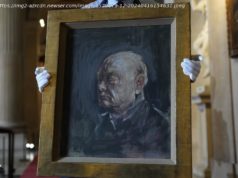The designer insisted on his freedom and worked, argued, and cooked on his own schedule.
Azzedine Alaïa, one of the greatest and most uncompromising designers of the 20th and 21st centuries, has died in Paris. He was 82. The cause was a heart attack. His company confirmed the news.
Known as a sculptor of the female form, and worn by women from Michelle Obama to Lady Gaga, Mr. Alaïa was equally famous for his rejection of the fashion system, and his belief that it had corrupted the creative power of what could be an art form. He rarely hewed to the official show calendar, preferring to reveal his work when he deemed it ready, as opposed to when retailers or press demanded it.
Instead he built his own system, and family of supporters, and since the turn of the millennium he had become an increasingly important voice for the value of striving to perfect and explore a single proprietary aesthetic, and against giving in to the relentless pressure to produce collections.
His kitchen, where he was famous for holding free-flowing lunch and dinner gatherings, for which he often cooked, was his soapbox, and he would regale guests — who could range from designers come to pay homage to Kardashians, the artist Julian Schnabel, the architect Peter Marino and seamstresses from his ateliers — long into the night with opinion, stories and exhortations.
Short — at least compared to the supermodels such as Naomi Campbell, who called him “Papa” and Farida Khelfa — he was always attired in a uniform of black Chinese cotton pajamas, and was famous for working alone long into the night, bent over patterns and pieces of fabric, with National Geographic programs playing on the wide screen TV nearby. Mr. Alaïa was also mischievous (he often lied about his age, once told a journalist his mother was a Swedish model, and like to hide from his atelier staff members and then startle them by jumping out with a whistle), prone to grudges and extraordinarily generous.
He dedicated his life to the belief that fashion was more than just garments, but rather an element in the empowerment of women and the broader cultural conversation.
An exhibit of his work at the Villa Borghese in Rome in 2015, where his gowns held their own among the Caravaggios and Berninis, proved he had achieved that goal.
Born in Tunisia in 1935,Mr. Alaïa came to Paris in 1957 to work with Christian Dior, living in the “chambre de bonne” of Comtesse Nicole de Blégiers, and paying his rent by making clothes for her and babysitting her children. Word spread, and he became an inside secret of the great and good of French society; clients included the writer Louise de Vilmorin, Cécile and Marie-Hélène de Rothschild, and the actress Arletty. He opened his own maison in 1979.
He introduced his first ready-to-wear collection in 1980, and was heralded as “the king of cling” — though in fact his garments were much more than that: He used leather and knits to shape and support the body, transforming it into the best version of itself. Though his aesthetic fell out of fashion with the advent of deconstructed minimalism in the 1990s, Mr. Alaïa never allowed himself to be distracted by the trends of others, and by the year 2000, acolytes began returning to his atelier on Rue de Moussy in the Fourth Arrondissement, the complex of buildings where he lived, worked and cooked.
In 2007, Compagnie Financière Richemont bought a majority stake in the business, allowing it to expand at its own pace: A perfume was introduced, store expansion planned and by last year Mr. Alaïa had more than 300 points of sale globally. Beyond the runway, he created work for the ballet and the opera, began holding art exhibitions in 2004 in the space that also houses his showroom (regular programming began in 2015 with an exhibition by the Syrian poet Adonis), and was planning a bookstore.
Mr. Alaïa returned to the couture calendar in July after six years, and in the audience were Jack Lang, the former French minister of culture; Carla Bruni-Sarkozy, former first lady of France (and one-time Alaïa model); Isabelle Huppert, the actor; Marc Newson, the industrial designer; and Fabrice Hergott, the director of the Museum of Modern Art in Paris. He had become the equivalent of a national treasure, and everyone was there to honor him.
He is survived by his nieces and nephews; his partner, the painter Christoph von Weyhe; his closest collaborator, Carla Sozzani, and all those who worked with him.






